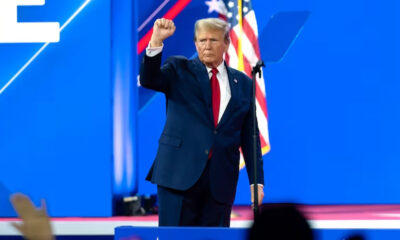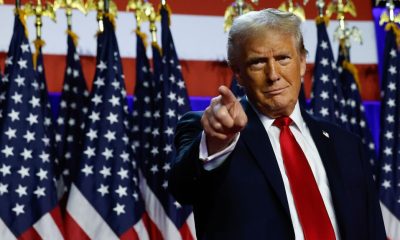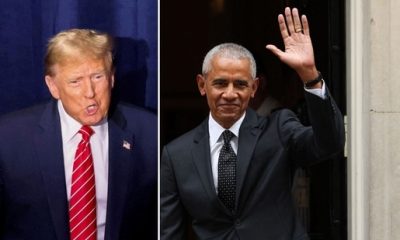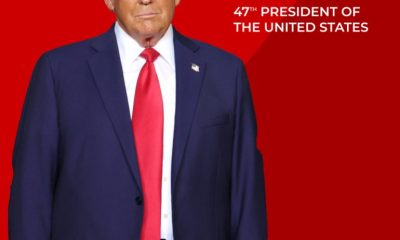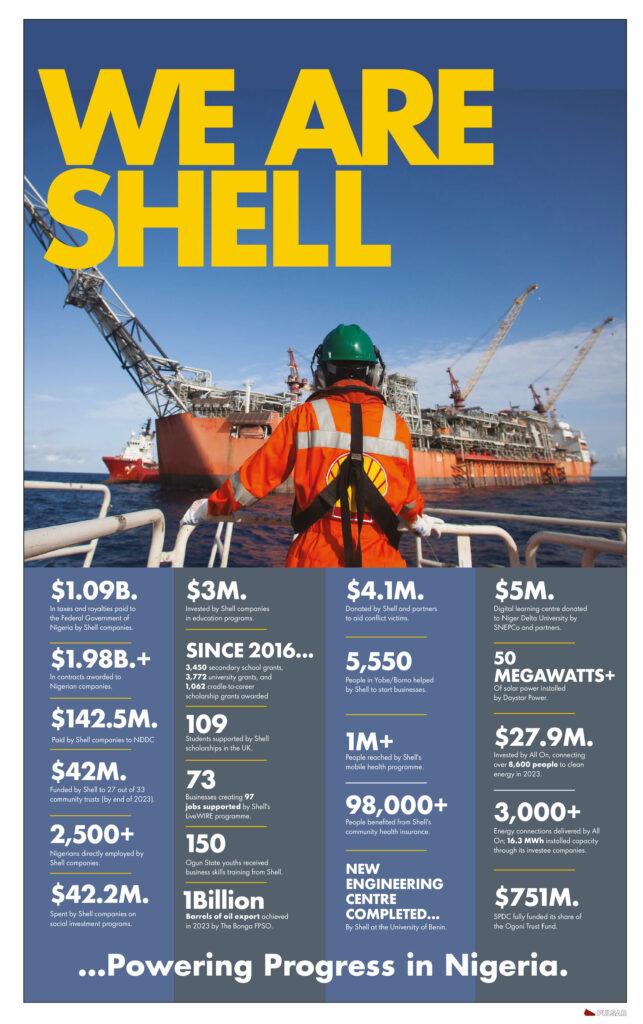International
Did Kamala Harris truly floor Donald Trump in the first fiery TV debate?
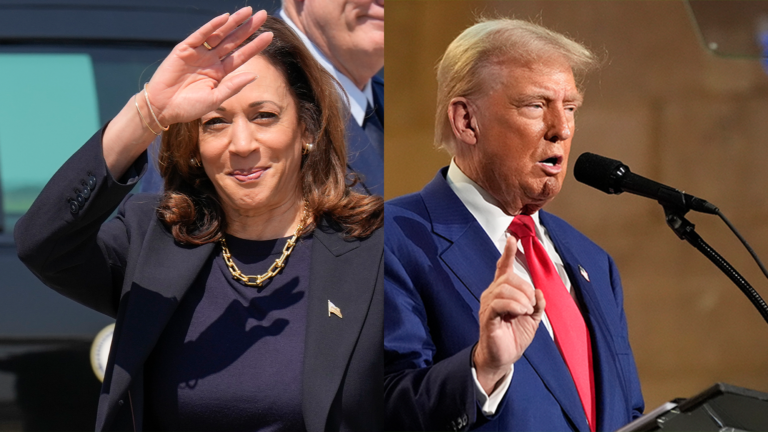
Did Kamala Harris truly floor Donald Trump in the first fiery TV debate?
*Read six highlights of the duel
Millions of viewers in the US watched Kamala Harris and Donald Trump duel for the first time, during a 90-minute debate broadcast live on many international TV stations on Tuesday night.
Others woke up to the aftermath of the presidential showdown.
In case you missed the televised spectacle, here are the some of the highlights as compiled by the BBC News.
1. ‘Nice to see you’
As they walked out, Harris strode across the stage to Trump as he approached his podium.
“Kamala Harris,” she said, offering a handshake as the pair met for the first time ever. “Let’s have a good debate.”
“Nice to see you. Have fun,” Trump said.
It was the first handshake in a presidential debate in eight years.
Harris spent the majority of the debate looking directly at her opponent, often smirking, laughing out loud, or shaking her head incredulously while he answered questions.
The split screen showed Trump staring mostly straight ahead as she spoke, while occasionally shaking his head.
2. ‘I’m talking now’
Vice-President Harris, a Democrat, went on the offensive from the outset, goading her Republican rival and assailing him over his criminal trials and his handling of the COVID-19 pandemic.
She also accused her opponent of consistently using the issue of race to “divide the American people”.
The barb followed a question from the moderators about one recent attack in which he said Harris had “become a black person”.
Trump turned the subject repeatedly back to inflation and immigration, political vulnerabilities for Harris.
He argued that the Biden-Harris administration had “destroyed” the country, and labelled her a “Marxist”, nodding to her father, a professor of economics.
Harris poked fun at crowd sizes at his rallies. “People start leaving his rallies early out of exhaustion and boredom,” she said.
Trump hit back: “People don’t go to her rallies. There’s no reason to go.”
At one stage, when Harris interrupted Trump, he said: “I’m talking now. Does that sound familiar?” He was referring to a similar riposte she made in a 2020 vice-presidential debate against Mike Pence.
Later, as Harris spoke over him, Trump said: “Quiet please.”
Trump also blamed heated Democratic rhetoric for the assassination attempt against him in July by a gunman whose motives are unknown.
“I probably took a bullet to the head because of the things they said about me,” he said.
3. ‘They’re eating the dogs’
In the hours before the debate, social media was filled with reports of unsubstantiated claims – repeated by JD Vance, Trump’s running mate, that Haitian migrants in Springfield, Ohio, had been stealing pets and eating them.
Despite city officials telling the BBC there are no credible reports to support these claims, Trump brought up the matter in the debate.
“They’re eating the dogs, they’re eating the cats, they’re eating the pets of the people that live there. This is a shame,” he said.
“Talk about extreme,” Harris said of her rival.
4. Moderator’s abortion fact-check
Some of Harris’s most aggressive attacks on Trump came as they clashed on abortion, one of the biggest issues for Democrats since the US Supreme Court overturned a constitutional right to the procedure in 2022.
“One does not have to abandon their faith or deeply held beliefs to agree the government – and Donald Trump, certainly – should not be telling a woman what to do with her body,” Harris said.
She said Trump would “sign an abortion ban” if re-elected and cited conservative states that prohibit the procedure while allowing limited exceptions.
Trump, for whom the issue is a political liability, countered: “What she says is an absolute lie. I am not in favour of an abortion ban.”
Trump reiterated that he supports exceptions for cases of rape, incest or when the life of the mother is at risk.
At one point Trump claimed that some babies were being subjected to “executions” after birth.
One of the ABC moderators interceded to fact-check him, saying: “There is no state in this country where it is legal to kill a baby after it’s born.”
5. Policies?
Trump said Harris had no policies, accusing her of copying some of his own ideas on the campaign trial and that he was “going to send her a Maga hat”, while also arguing she would be no different from President Biden.
“She has no policy,” he said.
“Remember this, she is Biden,” he said at another point.
Harris countered: “Clearly, I am not Joe Biden.”
Trump, who while president tried to overturn to Obamacare, was asked what would be his plan now to replace the Affordable Care Act.
He said he had “concepts of a plan” that would be “something that’s better”, if elected.
On the economy, an issue that opinion polls show favours Trump, Harris repeatedly stated: “I have a plan.”
6. Harris owns a gun
In the exchange that followed Harris’s insistence that she had a plan for the economy, Trump sought to depict his rival as a radical liberal who was also opposed to gun ownership.
He said: “She has a plan to defund the police. She has a plan to confiscate everyone’s guns. She has a plan to ban fracking in Pennsylvania and everywhere else.”
Harris denied all this.
“[Running mate] Tim Walz and I are both gun owners,” she said. “We’re not taking anybody’s guns away.”
She has spoken of her gun ownership in the past – but is a supporter of tougher laws.
BBC’s Anthony Zurcher reports that if debates are won and lost on which candidate best takes advantage of issues where they are strong – and defends or deflects on areas of weakness – Tuesday night tilted in favour of the vice-president.
A snap CNN poll of voters watching said that Harris performed better and betting markets said the same.
A poll taken by the CNN shortly after the debate indicates that Harris has 63 per cent against Trump’s 37.
International
Syria not threat to world, rebel leader al-Sharaa tells BBC
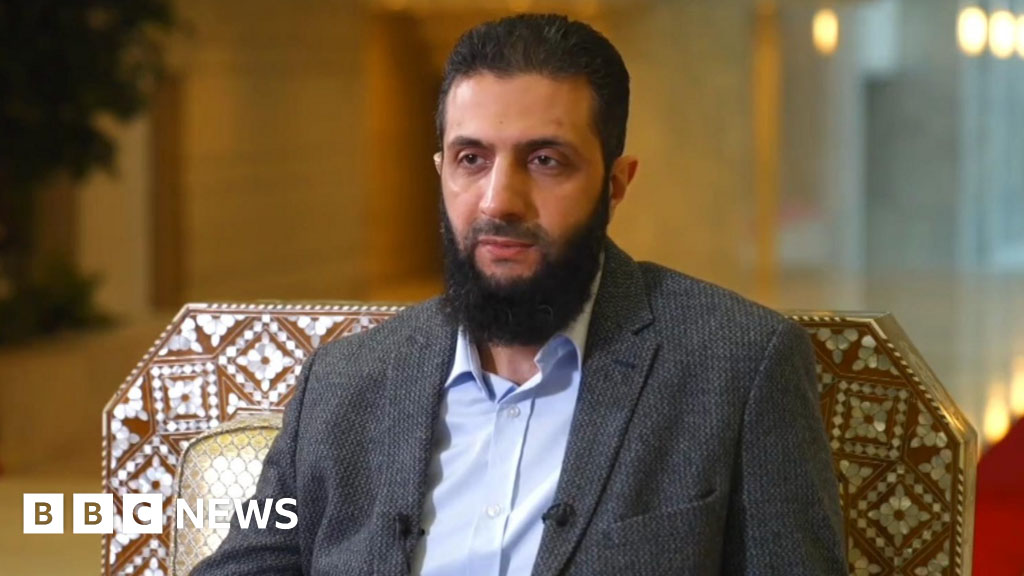
Syria not threat to world, rebel leader al-Sharaa tells BBC
The de facto leader of Syria, Ahmed al-Sharaa, has said the country is exhausted by war and is not a threat to its neighbours or to the West.
In an interview with the BBC in Damascus, he called for sanctions on Syria to be lifted.
“Now, after all that has happened, sanctions must be lifted because they were targeted at the old regime. The victim and the oppressor should not be treated in the same way,” he said.
Sharaa led the lightning offensive that toppled Bashar al-Assad’s regime less than two weeks ago. He is the leader of the Hayat Tahrir al-Sham (HTS), the dominant group in the rebel alliance, and was previously known by his nom de guerre of Abu Mohammed al-Jolani.
He said HTS should be de-listed as a terrorist organisation. It is designated as one by the UN, US, EU and UK, among many others, as it started as a splinter group of al-Qaeda, which it broke away from in 2016.
Sharaa said HTS was not a terrorist group.
They did not target civilians or civilian areas, he said. In fact, they considered themselves to be victim of the crimes of the Assad regime.
He denied that he wanted to turn Syria into a version of Afghanistan.
READ ALSO:
- Tinubu’s 2025 budget will increase poverty, worsen economy – PDP
- Real Madrid outclass Pachuca to win FIFA Intercontinental Cup
- Israel hits ports, energy sites in Yemen after missile intercepted
Sharaa said the countries were very different, with different traditions. Afghanistan was a tribal society. In Syria, he said, there was a different mindset.
He said he believed in education for women.
“We’ve had universities in Idlib for more than eight years,” Sharaa said, referring to Syria’s north-western province that has been held by rebels since 2011.
“I think the percentage of women in universities is more than 60%.”
And when asked whether the consumption of alcohol would be allowed, Sharaa said: “There are many things I just don’t have the right to talk about because they are legal issues.”
He added that there would be a “Syrian committee of legal experts to write a constitution. They will decide. And any ruler or president will have to follow the law”.
Sharaa was relaxed throughout the interview, wearing civilian clothes, and tried to offer reassurance to all those who believe his group has not broken with its extremist past.
Many Syrians do not believe him.
The actions of Syria’s new rulers in the next few months will indicate the kind of country they want Syria to be – and the way they want to rule it.
Syria not threat to world, rebel leader al-Sharaa tells BBC
BBC
International
Israel hits ports, energy sites in Yemen after missile intercepted

Israel hits ports, energy sites in Yemen after missile intercepted
JERUSALEM: Israel said Thursday it struck ports and energy infrastructure it alleges are used by Houthi militants, after intercepting a missile fired by the group.
Israel’s military said it “conducted precise strikes on Houthi military targets in Yemen — including ports and energy infrastructure in Sanaa, which the Houthis have been using in ways that effectively contributed to their military actions.”
The announcement came shortly after Israel said it had intercepted a missile fired from Yemen.
Al-Masira, a media channel belonging to the Houthis, said a series of “aggressive raids” were launched in the Yemeni capital of Sanaa and the port city of Hodeidah.
It reported raids that “targeted two central power plants” in Yemen’s capital Sanaa, while in Hodeidah it said “the enemy launched four aggressive raids targeting the port… and two raids targeting” an oil facility.
The strikes were the second time this week that Israel’s military has intercepted a missile from Yemen.
On Monday, the Houthis claimed a missile launch they said was aimed at “a military target of the Israeli enemy in the occupied area of Yaffa” — a reference to Israel’s Tel Aviv area.
READ ALSO:
- Gaza mediators intensify ceasefire efforts, Israeli strikes kill 20 people
- PDP expels South-East national vice chairperson over anti-party activities
- Your information on $1bn investment misleading, Dangote Refinery replies NNPCL
Also Monday, an Israeli navy missile boat intercepted a drone in the Mediterranean after it was launched from Yemen, the military said.
The Houthi militants have said they are acting in solidarity with Palestinians and pledged Monday to continue operations “until the aggression on Gaza stops and the siege is lifted.”
On December 9, a drone claimed by Houthis exploded on the top floor of a residential building in the central Israel city of Yavne, causing no casualties.
In July, a Houthi drone attack in Tel Aviv killed an Israeli civilian, prompting retaliatory strikes on the Yemeni port of Hodeidah.
The Houthis have also regularly targeted shipping in the Red Sea and the Gulf of Aden, leading to retaliatory strikes on Houthi targets by United States and sometimes British forces.
Israeli military spokesman Daniel Hagari said the group had become a “global threat,” pointing to Iran’s support for the militants.
“We will continue to act against anyone, anyone in the Middle East, that threatens the state of Israel,” he said.
Israel hits ports, energy sites in Yemen after missile intercepted
International
Gaza mediators intensify ceasefire efforts, Israeli strikes kill 20 people

Gaza mediators intensify ceasefire efforts, Israeli strikes kill 20 people
CAIRO: The United States, joined by Arab mediators, sought on Wednesday to conclude an agreement between Israel and Hamas to halt the 14-month-old war in the Gaza Strip where medics said Israeli strikes killed at least 20 Palestinians overnight.
A Palestinian official close to the negotiations said on Wednesday that mediators had narrowed gaps on most of the agreement’s clauses. He said Israel had introduced conditions which Hamas rejected but would not elaborate.
On Tuesday, sources close to the talks in Cairo, the Egyptian capital, said an agreement could be signed in coming days on a ceasefire and a release of hostages held in Gaza in return for Palestinian prisoners held by Israel.
Medics said an Israeli airstrike killed at least 10 people in a house in the northern town of Beit Lahiya while six were killed in separate airstrikes in Gaza City, Nuseirat camp in central areas, and Rafah near the border with Egypt.
In Beit Hanoun in the northern Gaza Strip, medics said four people were killed in an airstrike on a house. There was no immediate comment from the Israeli military spokesman.
Israeli forces have operated in the towns of Beit Hanoun and Beit Lahiya as well as the nearby Jabalia camp since October, in a campaign the military said aimed to prevent Hamas militants from regrouping.
Palestinians accuse Israel of carrying out acts of “ethnic cleansing” to depopulate the northern edge of the enclave to create a buffer zone. Israel denies it.
READ ALSO:
- PDP expels South-East national vice chairperson over anti-party activities
- Your information on $1bn investment misleading, Dangote Refinery replies NNPCL
- Many die at Ibadan children’s Christmas party stampede, organisers arrested
Hamas does not disclose its casualties, and the Palestinian health ministry does not distinguish in its daily death toll between combatants and non-combatants.
On Wednesday, the Israeli military said it struck a number of Hamas militants planning an imminent attack against Israeli forces operating in Jabalia.
Later on Wednesday, Muhammad Saleh, director of Al-Awda Hospital in Jabalia, said Israeli shelling in the vicinity damaged the facility, wounding seven medics and one patient inside the hospital.
The Israeli military had no immediate comment.
In the Central Gaza camp of Bureij, Palestinian families began leaving some districts after the army posted new evacuation orders on X and in written and audio messages to mobile phones of some of the population there, citing new firing of rockets by Palestinian militants from the area.
CEASEFIRE GAINS MOMENTUM
The US administration, joined by mediators from Egypt and Qatar, has made intensive efforts in recent days to advance the talks before President Joe Biden leaves office next month.
In Jerusalem, Israeli President Isaac Herzog met Adam Boehler, US President-elect Donald Trump’s designated envoy for hostage affairs. Trump has threatened that “all hell is going to break out” if Hamas does not release its hostages by Jan. 20, the day Trump returns to the White House.
CIA Director William Burns was due in Doha on Wednesday for talks with Qatari Prime Minister Sheikh Mohammed bin Abdulrahman Al-Thani on bridging remaining gaps between Israel and Hamas, other knowledgeable sources said. The CIA declined to comment.
Israeli negotiators were in Doha on Monday looking to bridge gaps between Israel and Hamas on a deal Biden outlined in May.
There have been repeated rounds of talks over the past year, all of which have failed, with Israel insisting on retaining a military presence in Gaza and Hamas refusing to release hostages until the troops pulled out.
The war in Gaza, triggered by a Hamas-led attack on communities in southern Israel that killed some 1,200 people and saw more than 250 abducted as hostages, has sent shockwaves across the Middle East and left Israel isolated internationally.
Israel’s campaign has killed more than 45,000 Palestinians, displaced most of the 2.3 million population and reduced much of the coastal enclave to ruins.
Gaza mediators intensify ceasefire efforts, Israeli strikes kill 20 people
ARAB NEWS
-

 Railway19 hours ago
Railway19 hours agoLagos Rail Mass Transit part of FG free train ride – NRC
-

 metro2 days ago
metro2 days agoCourt stops customs from seizing imported rice in open market
-
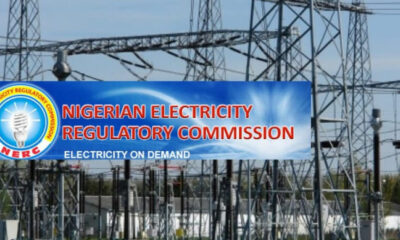
 metro3 days ago
metro3 days agoFG transfers electricity market regulatory oversight in Lagos to LASERC
-

 metro2 days ago
metro2 days agoIbadan stampede: Tinubu orders probe as death toll hits 40
-
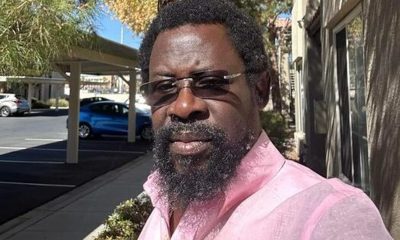
 metro2 days ago
metro2 days agoAfe Babalola: Court grants Dele Farotimi bail, barred from media interviews
-

 metro1 day ago
metro1 day agoIbadan stampede: Ooni reacts after arrest of ex-wife
-
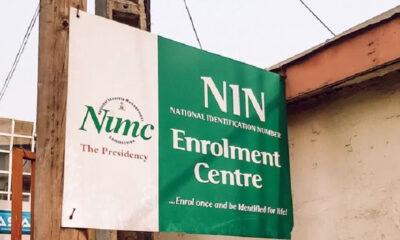
 metro19 hours ago
metro19 hours agoNIMC warns against extortion, reaffirms free NIN enrollment
-
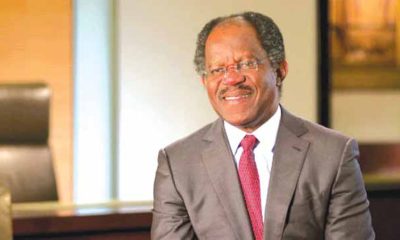
 News2 days ago
News2 days agoAdebayo Ogunlesi, 2 other Nigerians make Forbes 50 wealthiest Black Americans list 2024



